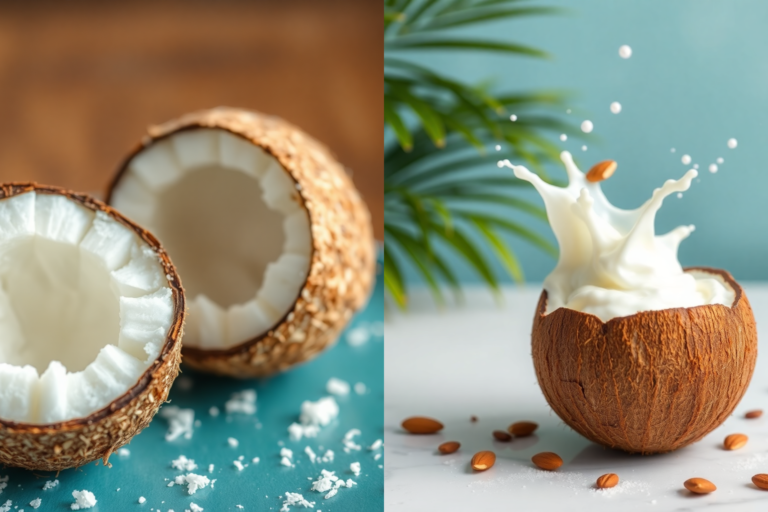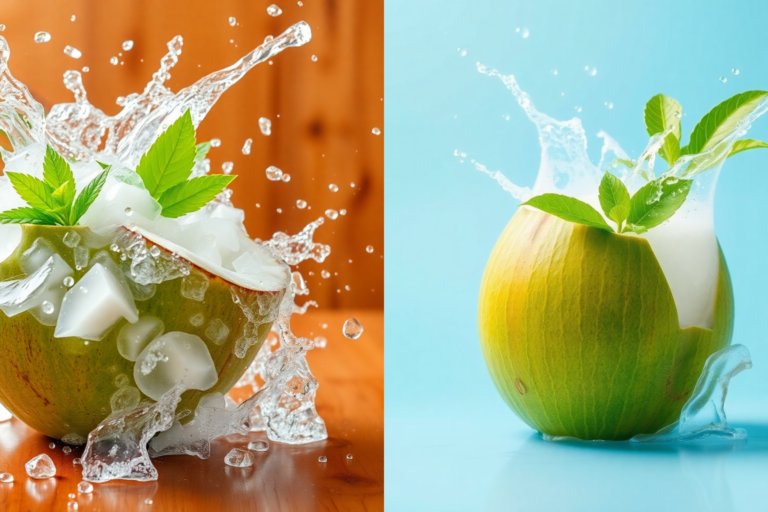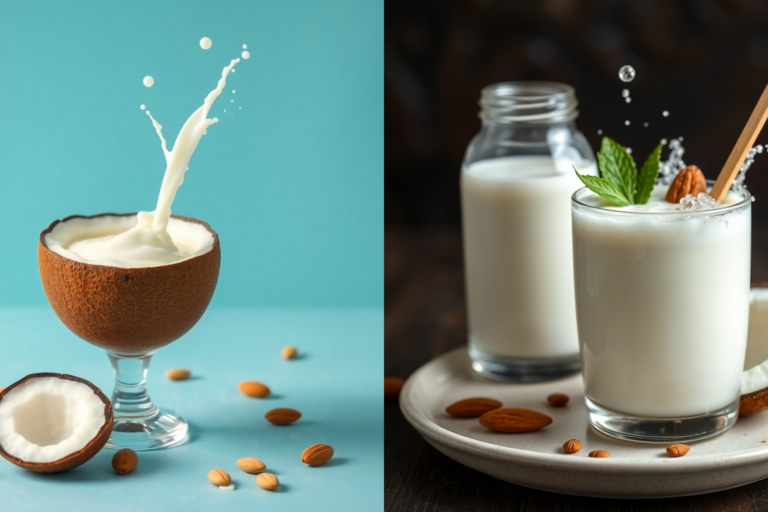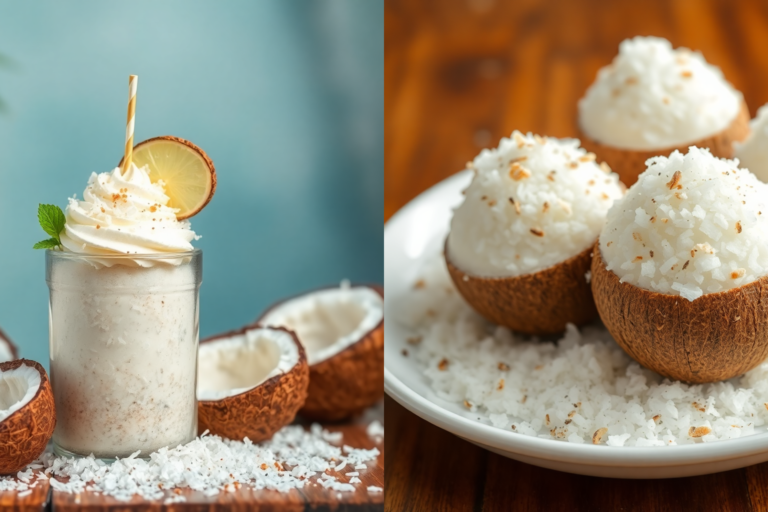Introduction to Desiccated Coconut
Brief Overview of Desiccated Coconut
Desiccated coconut is a finely grated, dried form of coconut flesh that has become a staple ingredient in many kitchens around the world. Derived from the white meat of mature coconuts, desiccated coconut undergoes a drying process to reduce its moisture content, making it shelf-stable and easy to store for long periods. This versatile ingredient is available in various grades, from fine to medium, catering to different culinary needs. The rich, nutty flavor of desiccated coconut adds a delightful tropical twist to a wide array of dishes, especially in baking and confectionery.
Desiccated coconut retains much of the natural sweetness and nutritional benefits of fresh coconut, including dietary fiber, healthy fats, and essential minerals. This makes it not only a flavorful addition but also a healthful one, enriching recipes with both taste and nutrition.
Importance of Desiccated Coconut in Baking
In the world of baking, desiccated coconut holds a special place due to its unique ability to enhance texture and flavor in a variety of baked goods. The finely shredded nature of desiccated coconut allows it to blend seamlessly into batters and doughs, providing a consistent distribution of its characteristic coconut taste.
Enhancing Texture
Desiccated coconut is renowned for its role in improving the texture of baked goods. When incorporated into recipes, it imparts a slight chewiness and a pleasant crunch, depending on the grade used. This textural enhancement is particularly valued in cookies, cakes, and muffins, where a contrast between a soft crumb and a slightly crispy bite can elevate the overall eating experience.
Boosting Flavor
The addition of desiccated coconut to baking recipes infuses a subtle yet distinctive tropical flavor that complements a wide range of other ingredients, from chocolate to citrus fruits. This flavor boost is essential in recipes where coconut is a key component, such as coconut cookies, cakes, and macaroons, providing an authentic coconut taste that is both rich and aromatic.
Versatility in Recipes
Desiccated coconut’s versatility extends to its use in various baking applications, such as toppings, fillings, and even crusts. It can be toasted for an added depth of flavor or used as is for a more delicate taste. This adaptability makes desiccated coconut an indispensable ingredient for both amateur bakers and professional chefs looking to add a tropical flair to their creations.
In summary, desiccated coconut is a vital ingredient in baking due to its ability to enhance texture, boost flavor, and adapt to a wide range of recipes. Whether used in cookies, cakes, or pie crusts, desiccated coconut brings a touch of the tropics to baked goods, making them more enjoyable and memorable.
Coconut Cookies with Desiccated Coconut
A Delightful Treat with Desiccated Coconut
Coconut cookies are a beloved treat that perfectly balance sweetness with a rich, tropical flavor. By incorporating desiccated coconut, these cookies gain a delightful texture and a deeper, more intense coconut flavor that is both satisfying and unique. Desiccated coconut, finely shredded and dried, offers an excellent way to infuse your cookies with the essence of coconut without adding extra moisture, making it ideal for baking.
Recipe Ideas for Coconut Cookies
Creating coconut cookies with desiccated coconut is simple and can be easily adapted to suit various tastes and dietary needs. Here’s a basic recipe idea to get you started:
Classic Coconut Cookies Recipe
Ingredients:
- 1 cup all-purpose flour
- 1/2 cup desiccated coconut
- 1/2 teaspoon baking powder
- 1/4 teaspoon salt
- 1/2 cup unsalted butter, softened
- 1/2 cup granulated sugar
- 1 large egg
- 1 teaspoon vanilla extract
Instructions:
- Preheat the oven to 350°F (175°C) and line a baking sheet with parchment paper.
- In a medium bowl, whisk together the flour, desiccated coconut, baking powder, and salt.
- In a large bowl, beat the butter and sugar until light and fluffy.
- Add the egg and vanilla extract to the butter mixture and mix until well combined.
- Gradually add the dry ingredients to the wet ingredients, mixing until just combined.
- Drop spoonfuls of dough onto the prepared baking sheet, spacing them about 2 inches apart.
- Bake for 10-12 minutes or until the edges are golden brown.
- Let the cookies cool on the baking sheet for a few minutes before transferring them to a wire rack to cool completely.
Benefits of Adding Desiccated Coconut to Cookies
Incorporating desiccated coconut into coconut cookies offers several benefits that enhance the overall baking experience:
Texture Enhancement
The fine shreds of desiccated coconut add a delightful chewiness to the cookies, giving them a more complex texture that contrasts beautifully with the crisp edges. This addition makes each bite a textural adventure, appealing to those who appreciate a bit of extra crunch and chew in their cookies.
Flavor Amplification
Desiccated coconut amplifies the natural sweetness of the cookies, imparting a richer, more nuanced coconut flavor. It elevates the taste profile, making the cookies more aromatic and inviting, with a hint of tropical indulgence.
Versatile Ingredient
Desiccated coconut is a versatile ingredient that can easily be incorporated into various cookie recipes, whether you’re making classic coconut cookies, adding chocolate chips for a chocolate-coconut twist, or including nuts for extra crunch. The possibilities are endless, and the results are always delicious.
Coconut Cakes: A Delightful Tropical Treat with Desiccated Coconut
Incorporating Desiccated Coconut into Cake Batter
Desiccated coconut can be a game-changer when it comes to enhancing the flavor and texture of your cake batter. By adding desiccated coconut to your cake mix, you infuse each bite with a burst of tropical essence. Typically, about 1/2 to 1 cup of desiccated coconut can be folded into the batter, depending on the recipe’s size. The fine, dried coconut pieces integrate smoothly, ensuring a uniform distribution throughout the cake. This incorporation not only adds a subtle crunch but also helps in maintaining the cake’s moisture, resulting in a perfectly moist and fluffy texture.
Using Desiccated Coconut in Frosting
Desiccated coconut isn’t just limited to the cake batter; it can also elevate your frosting. A coconut buttercream or cream cheese frosting can be transformed by folding in desiccated coconut, adding both texture and a deeper coconut flavor. Sprinkling desiccated coconut on top of the frosted cake enhances its visual appeal, creating a rustic, homemade look. For a more pronounced tropical twist, lightly toasting the desiccated coconut before adding it as a topping can bring out a richer, nuttier flavor that complements the sweetness of the frosting.
Enhancing the Tropical Flavor Profile with Desiccated Coconut
Desiccated coconut is the star ingredient when aiming to amplify the tropical flavor profile of your cakes. Its naturally sweet and nutty taste harmonizes beautifully with other tropical ingredients such as pineapple, lime, or mango, which can be incorporated into the cake or as a filling. The use of desiccated coconut not only enriches the flavor but also provides a unique texture that sets your coconut cake apart. Whether you’re crafting a classic coconut layer cake or experimenting with exotic variations, desiccated coconut is indispensable for achieving that signature tropical flair.
This section emphasizes the versatility and importance of desiccated coconut in creating delicious and memorable coconut cakes. Would you like to add more recipe-specific details or further elaborate on any of these points?
Coconut Muffins: Using Desiccated Coconut in Muffin Recipes
Why Use Desiccated Coconut in Muffin Recipes?
Desiccated coconut is a versatile ingredient that adds a delightful texture and flavor to muffin recipes. When incorporated into muffins, desiccated coconut enhances the overall eating experience by providing a subtle tropical taste and a slightly chewy texture that contrasts beautifully with the soft crumb of the muffins. Its fine, dry flakes make it easy to mix into batters without altering the moisture content drastically, ensuring your muffins remain balanced and flavorful.
Benefits of Adding Desiccated Coconut to Muffins
Enhanced Texture
Desiccated coconut adds a pleasant chewiness to muffins, making each bite more interesting and satisfying. The tiny coconut flakes distribute evenly throughout the batter, ensuring every muffin is packed with a consistent texture. This enhances the overall mouthfeel, making desiccated coconut an essential addition to any muffin recipe looking for a texture boost.
Improved Flavor Profile
Desiccated coconut infuses muffins with a mild, sweet, nutty flavor that complements a variety of other ingredients like vanilla, chocolate, or fruits. Its tropical notes can transform a simple muffin into an exotic treat. Using desiccated coconut in your muffin recipes elevates the flavor profile, making them stand out in a sea of ordinary baked goods.
Tips for Achieving Moist and Flavorful Coconut Muffins
Balance the Moisture Content
While desiccated coconut is dry, it can absorb some of the liquid in your muffin batter. To achieve moist muffins, slightly increase the amount of liquid ingredients, such as milk or coconut milk. This compensates for the moisture absorbed by the desiccated coconut, ensuring your muffins remain soft and tender.
Toast the Desiccated Coconut
To deepen the flavor, lightly toast the desiccated coconut before adding it to the muffin batter. Toasting brings out the natural oils in the coconut, enhancing its nutty aroma and adding a golden hue to the flakes. This step can significantly improve the taste of your coconut muffins.
Use a Combination of Coconut Products
For an even richer coconut flavor, consider using coconut milk or coconut oil along with desiccated coconut. These ingredients work synergistically to amplify the coconut essence in your muffins, resulting in a more pronounced tropical flavor.
Don’t Overmix the Batter
Overmixing the muffin batter can lead to tough muffins. Once you add the desiccated coconut, gently fold it into the batter just until combined. This helps maintain a light and airy texture in the finished muffins.
Add a Coconut Topping
For added visual appeal and an extra burst of flavor, sprinkle some desiccated coconut on top of the muffins before baking. The flakes will toast slightly in the oven, creating a crispy, golden topping that contrasts beautifully with the moist interior.
Coconut Pie Crust with Desiccated Coconut
How Desiccated Coconut Can Be Used in Pie Crusts
Desiccated coconut is a versatile ingredient that can add a delightful twist to traditional pie crusts. By incorporating desiccated coconut into your pie crust, you introduce a subtle tropical flavor that complements a variety of fillings, from fruity to creamy. The fine texture of desiccated coconut blends seamlessly with the flour and butter, creating a crust that is both crisp and flavorful.
Enhancing the Texture
Using desiccated coconut in your pie crust not only enhances the flavor but also improves the texture. The coconut flakes add a slight crunch that contrasts beautifully with smooth pie fillings. Whether you’re making a key lime pie or a classic chocolate cream pie, the addition of desiccated coconut can elevate the overall eating experience.
Creating a Unique Twist on Traditional Pie Crusts
Combining Ingredients
To create a coconut pie crust, simply substitute a portion of the flour in your favorite pie crust recipe with desiccated coconut. For example, if your recipe calls for two cups of flour, you can use one and a half cups of flour and half a cup of desiccated coconut. This adjustment maintains the structure of the crust while infusing it with the tropical essence of coconut.
Baking Tips
When using desiccated coconut in your pie crust, it’s important to monitor the baking time carefully. Desiccated coconut tends to brown more quickly than traditional flour, so you may need to cover the edges of the crust with foil halfway through baking to prevent over-browning. This ensures your pie crust remains golden and crisp without becoming overly dark.
Pairing with Fillings
Desiccated coconut pie crusts pair exceptionally well with tropical or fruity fillings. Think mango, pineapple, or passion fruit curd, which complement the coconut’s natural sweetness. For a more decadent option, a chocolate or coconut cream filling also works wonderfully, enhancing the coconut flavor profile and creating a cohesive dessert.
Coconut Macaroons: A Classic Use of Desiccated Coconut
Introduction to Coconut Macaroons and Desiccated Coconut
Coconut macaroons are a timeless, chewy, and sweet treat loved for their rich coconut flavor. The key ingredient that gives these cookies their signature texture and flavor is desiccated coconut. Desiccated coconut is finely shredded, dried coconut meat that has a light, powdery texture. It holds moisture well, making it perfect for achieving that chewy consistency in macaroons. Whether you are baking for a special occasion or simply craving something sweet, desiccated coconut is the ideal ingredient to elevate the flavor of this classic dessert.
How to Use Desiccated Coconut in Macaroons
The classic recipe for coconut macaroons calls for just a few simple ingredients: desiccated coconut, egg whites, sugar, and vanilla extract. The desiccated coconut is the star of this dessert, providing both structure and sweetness. The finely shredded coconut absorbs the egg whites and sugar to create the chewy texture that makes macaroons so special. The key is to use the right amount of desiccated coconut—too little and your macaroons will lack the signature coconut chewiness; too much, and they may become too dry.
Steps to Make Perfect Coconut Macaroons
- Preheat the Oven: Set your oven to 325°F (165°C) to ensure even baking.
- Mix the Ingredients: In a mixing bowl, combine desiccated coconut, sugar, egg whites, and vanilla extract. Stir the ingredients together until the mixture is fully combined. If you prefer a slightly more moist macaroon, you can add a little sweetened condensed milk in place of some of the sugar.
- Shape the Macaroons: Using a spoon or your hands, form small mounds of the coconut mixture on a baking sheet lined with parchment paper. Gently pack them together to ensure they hold their shape while baking.
- Bake to Perfection: Place the baking sheet in the preheated oven and bake for 15-20 minutes or until the macaroons turn golden brown on top. The desiccated coconut should become toasted, giving the macaroons a beautiful, crispy texture on the outside while maintaining their chewy interior.
- Cool and Serve: Allow the macaroons to cool on a wire rack before serving. This will help them firm up and become even chewier.
Tips for Perfecting Your Coconut Macaroons with Desiccated Coconut
- Use Fresh Desiccated Coconut: To achieve the best flavor and texture, always use fresh desiccated coconut. Older coconut may be drier and lack the same chewy consistency.
- Don’t Overmix: When combining the ingredients, be gentle. Overmixing the desiccated coconut with the other ingredients can result in macaroons that are too dense or dry.
- Watch the Oven: Since macaroons can burn quickly, it’s essential to keep an eye on them during the last few minutes of baking. You want them golden on the outside, but not overly dark.
- Add a Twist: For a fun variation, dip the cooled macaroons in melted chocolate or add a pinch of salt to enhance the coconut flavor. You could also fold in some dried fruits or nuts for added texture and taste.











